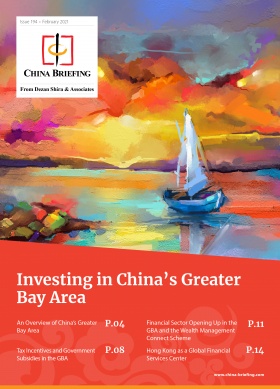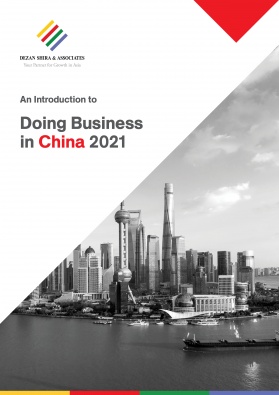Common Restructuring Options for Businesses in China
For company restructuring in China, businesses must strategize based on which options will bolster their operational sustainability and facilitate company preparedness and agility, factors that are essential during periods of crises like the pandemic.
Businesses looking to benefit from China’s economic rebound may consider how their corporate strategy could be optimized through restructuring their operations, HR, finances, or supply chains.
While a successful restructuring strategy can put the company in a better position to achieve its goals through greater operational efficiency, not all such undertakings end well.
Many factors will determine the effectiveness of a company restructuring plan, key among them being how the plan is interpreted by relevant stakeholders and implemented in practice.
It therefore helps when businesses have a good understanding of the challenges that can surface in each restructuring option and choose the most appropriate strategy for their entity.
In this article, we explain the various options open to foreign investors for company restructuring in China and how businesses can assess their feasibility.
External restructuring
As introduced in the previous article, external restructuring usually refers to the restructuring of the company equity, control rights, and assets to achieve relevant business purposes.
It could benefit, both, companies that want to overcome financial crises and those that want to optimize their investment portfolio and improve their competitiveness. Typical strategies under external restructuring include equity acquisition, asset transfer, merger, split-up, divestiture, etc.
Equity acquisition
Equity acquisitions occur when one company buys enough equity in another company to become its owner, that is, to gain the controlling stake. Together with the equity rights, the acquirer will also inherit the corresponding debt and liabilities of the acquired company, including potential liabilities from past actions of the business.
Legally, equity acquisition will involve a change of the shareholders. The licenses of the acquired company only need to be amended when relevant information is different, such as when a new legal representative is appointed to the acquired company after the transaction.
The operation of the acquired company is usually not interrupted, and the employment relationship is usually unaffected if the process turns out to be smooth. However, if the main business of the acquired company must be changed due to equity acquisition, or if the acquired company decides to relocate to a new location, operational and employment issues may still arise.
Equity acquisition is a suitable restructuring strategy when a company wants to acquire capabilities it cannot or does not want to develop internally, and when a company wants to enter into a niche market without going through the lengthy set-up process.
By becoming the controlling stakeholder of the acquired company, the acquirer can obtain difficult-to-acquire licenses, such as the permit for running schools, and also utilize the established experience and framework of the acquired company to better prepare for the market conditions they are about to face.
However, the effectiveness of such an acquisition is largely dependent on the makeup of both the acquiring company and the acquired company. Companies have different work cultures, management styles, and operational procedures.
It can be a difficult task to combine these and to cut away what does not work. The acquiring company can only gain a quick and strong foothold in the target market – when the two parties are compatible with each other.
For this reason, it is imperative that thorough due diligence of both companies is done beforehand on the assets, contracts, credit and debt, employment relationships, managements, to expose sensitive areas, disputes, and weaknesses so that the transaction is made on the basis of fair, transparent, and reasonable evaluations.
Another factor to be noted is that foreign investors that acquire a domestic company in China need to convert it to a foreign-invested enterprise (FIE). Consequently, all FIE rules and regulations must be observed, including restrictions on investment, qualifications of investors, and scope of business.
Asset acquisition
An asset acquisition is the purchase of a company by buying its valuable assets, such as the client relationship, the employee, the real estate, the machine, and the production line, etc.
Asset acquisition may involve an assumption of certain liabilities, but the buyer can pick and choose what liabilities to take and use them to bargain the transaction price in the later negotiation.
The ability to selectively assume the liabilities of the target company, rather than acquire all the liabilities (including unknown and undisclosed liabilities) as assumed in the equity acquisition, makes asset acquisition a safer restructuring option for businesses, considering it is not 100 percent guaranteed that all unknown liabilities can be identified by due diligence.
Nevertheless, the tax burden caused by asset acquisition is comparatively higher than that of the equity acquisition.
In equity acquisition, income tax occurs due to the equity transfer, in addition to the stamp tax caused by the contract. In asset acquisition, depending on the nature of the transferred assets, taxpayers may need to pay value-added tax, income tax, deed tax, and stamp tax, etc.
The use of an asset acquisition strategy is common when buyers only wish to gain the attractive assets owned by the target company but are not interested in acquiring the entire business operation. Sometimes, however, after the acquiring company gains control of the key assets that are important to the ongoing operation of the acquired company, it is equivalent to gaining control of the whole company.
Given the nature of the transaction, asset appraisal is a fundamental process to ensure the effective of the asset transaction. This is not only to assess the reasonable price of the transferred assets, but also to investigate if there are any potential risks that will affect the successful transfer of the assets, such as when one or more mortgage rights have been instituted on the targeting assets.
Correspondingly, a due diligence process is recommended to take care of this aspect.
Asset acquisition may result in changes to relevant licenses when the transferred assets are immovables, special equipment, or other assets that require licenses. It will also lead to certain staffing issues.
If the acquiring company only wants to take all the valuable assets (land, equipment, facilities, etc.) without the employees, then the transaction may lead to mass layoffs when the acquired company will cease operation after selling all major assets. If the acquiring company wants to pay for the human resources as well, then it may need to negotiate with the employees for potential relocation.
Also, the acquiring company and the inherited employees may have disputes later for the employee’s service period with the acquired company. Thus, the buyer and the seller are recommended to reach into agreement and make relevant arrangements in advance to avoid the potential HR risks.
Merger
Mergers are another form of corporate restructuring that is very similar to equity acquisition. However, while acquisition occurs when one company buys enough equity in another to become its controlling stakeholder, a merger combines two companies into one with all equity.
When two companies merge, they are often similar in size, scope, and capability. The primary reasons for mergers include gaining market share, reducing competition, improving costs and efficiency, and increasing profits.
Through merger, the management of the two companies can achieve better synergy within the organization and there is executive confidence that the newly formed company can compete better in the market than the separate companies could on their own.
Mergers are comparatively simple and cheaper to organize than their alternatives. The boards of the two companies must approve a combination of the businesses, as well as the terms of the merger.
The companies being merged are legally not required to be liquidated and de-registered (though they might be required to implement tax deregistration by local tax bureaus in practice).
When the merger deal is on an all-stock basis, that is, the shareholders of both merging companies are given the same value of shares in the new company that they owned in the old companies, no tax liability will occur.
Again, the effectiveness of the merger depends on how compatible the two parties in the newly formed entity are, like in the case of equity acquisition.
Split-up
A split-up is a restructuring option where a single company splits into two or more independent and separately run companies.
Companies undergo a split mainly for two reasons – to gain strategic advantages or to comply with the governmental mandate to combat monopolistic practices. The first is more common.
When companies split up for strategic advantages, they believe managing different business lines separately will maximize efficiency and profitability, because each business line would require its own resources, capital financing, and management personnel. This is especially the case where different departments of the company grow stronger and develop different operational requirements and focus.
The company split-up could be an onerous process in practice, considering the allocation of assets, rights, and liabilities. Sometimes the business would rather set up a new subsidiary instead.
Divestiture
Divestiture is a restructuring option where companies want to dispose their nonperforming or non-core assets or business units to reduce redundancy, generate funds, and ensure business survival or stability.
Divestiture transactions are like the other side of the merger and acquisition transactions.
Companies acquire the equity or asset of another firm to gain competitive advantages, but companies also have the need to sell to optimize their business.
Divestiture can be achieved by sale of assets or equity, split-up, closure, or bankruptcy.
Internal restructuring
Internal restructuring refers to alterations made internally on operations, capital, supply chains, human resources (HR), systems, legal frameworks, as well as locations of a company to make the business more integrated and profitable.
Companies with optimized structures can be better prepared to mitigate the impact of unexpected crises and make quick responses.
This is vitally important for businesses when uncertainties are increasing globally despite the positive trend in the selected market.
To implement internal restructuring, companies are suggested to conduct a series of reviews on their operations, such as financial review, legal review, HR audit, supply chain review, and so on, to find out the existing issues and identify areas that can be improved.
For example, through financial review, the company will have a chance to find out the neglected flaws in their current policies and practices and thus make relevant arrangements in advance to ensure the liquidity and stability of their company finance.
Internal restructuring has a broad scope that may involve every aspect of the business. To this article, we approach restructuring from the below perspective:
Supply chain
The global spread of COVID-19 has brought huge challenges to the supply chain management, but it can be observed that companies that performed better on sensing, responding, and even predicting the supply chain disruptions, benefited from the below practices:
- Development and implementation of supply chain risk management strategies.
- Diversifying their supply chain to avoid supplier dependency from a single country or region.
- Adoption of systems and technologies in supply chain management to provide visibility across the extended supply network, which enables better risk prediction, control, and actions based on priorities.
An assessment of the company’s performance on the above parameters and practices will help to make clear the objectives and directions of the supply chain restructuring needed. Companies that experienced supply chain shocks last year should seriously plan to reshape their global supply chains to prepare for the unpredictable tendencies in, both, the domestic and overseas market.
Human resources
To restructure and optimize a company’s human resource management, the company could start by considering the following aspects:
- Conducting regular HR health checks/ audits to identify wrongful practices that may lead to potential labor disputes and highlight areas that need to improve.
- Reviewing and re-designing the HR policies and procedures to let the employer have the upper hand in potential employment adjustments, such as renegotiating with employees about the termination clause in their contracts.
- Adopting tech-powered HR and payroll solutions to transform the business into more efficient and mobile operations with higher accuracy and fewer risk points.
- Exploring alternative and flexible employment forms to mitigate labor shortages in extreme cases and reduce labor costs.
Cash flow
In times of severe financial and operational strain, cash flow management plays an important part in a company’s bid to both survive and ultimately thrive. To optimize cash flow management, companies can start by implementing the following:
- Performing financial and liquidity stress tests to identify possible scenarios that have severe economic impact on the business.
- Producing rolling forecasts to identify, track, and mitigate risk factors, such as potential changes to cash conversion cycles with key suppliers and customers.
- Effective cost controls to reduce all noncritical uses of cash.
- Establishing new expenditure management policies and increasing levels of oversight and internal controls to ensure expenditures are limited to what is necessary.
- Adopting tech-powered accounting and expense management technologies to improve speed in work processing and speed of reporting to management.
Compliance and risk control
In the case of black swan events, such as the COVID-19 outbreak, it is understandable that companies may not be able to cover all bases when in fact they have overstretched their competency to survive and stabilize, before achieving recovery. However, it is also true that competitors with less flaws have a greater chance to succeed.
Generally, companies can optimize their compliance and risk control mechanism by doing the following:
- Conducting proactive and regular compliance reviews to identify the potential risk exposures.
- Developing standard protocols to prevent and tackle incompliance scenarios.
- Reviewing and revising the company’s contract templates to adapt to the new context, such as adding force majeure clauses to mitigate the fallout of unexpected circumstances.
Reduce operation
Companies may decide to get through the difficult time by temporarily reducing production and scope of operation. This usually happens to those whose consumer base and orders are seriously affected by the crisis, such as the offline entertainment industry affected by the lock-down.
By reducing operations temporarily, the business can cut costs while at the same time reserving the basic structure for future operations after the entity’s circumstances improves.
Nevertheless, there are a few compliance issues to pay attention to when pursuing this option:
- The company must maintain proper tax filing (monthly, quarterly and annually) with the tax bureau, even if no business activities are carried out and only a few personnel are employed. Where there is no revenue, the company can make zero-tax filing.
- The company must also structure its financial statements and the calculation of miscellaneous expenses (for example, bank interest/charges, rent, office expenses, etc.) to maintain positive compliance status as per Chinese accounting regulations.
- The company must comply with the tax authority’s annual reporting requirements to avoid being listed in the “Directory of Enterprises with Abnormal Operation”.
- The company must maintain proper office lease and the corporate bank account for basic operations.
About Us
China Briefing is written and produced by Dezan Shira & Associates. The practice assists foreign investors into China and has done so since 1992 through offices in Beijing, Tianjin, Dalian, Qingdao, Shanghai, Hangzhou, Ningbo, Suzhou, Guangzhou, Dongguan, Zhongshan, Shenzhen, and Hong Kong. Please contact the firm for assistance in China at china@dezshira.com.
Dezan Shira & Associates has offices in Vietnam, Indonesia, Singapore, United States, Germany, Italy, India, and Russia, in addition to our trade research facilities along the Belt & Road Initiative. We also have partner firms assisting foreign investors in The Philippines, Malaysia, Thailand, Bangladesh.
- Previous Article Beijing’s E-Town Rolls Out Favorable Policies to Boost High-Tech Development
- Next Article China Releases Supporting Measures for Three-Child Policy








